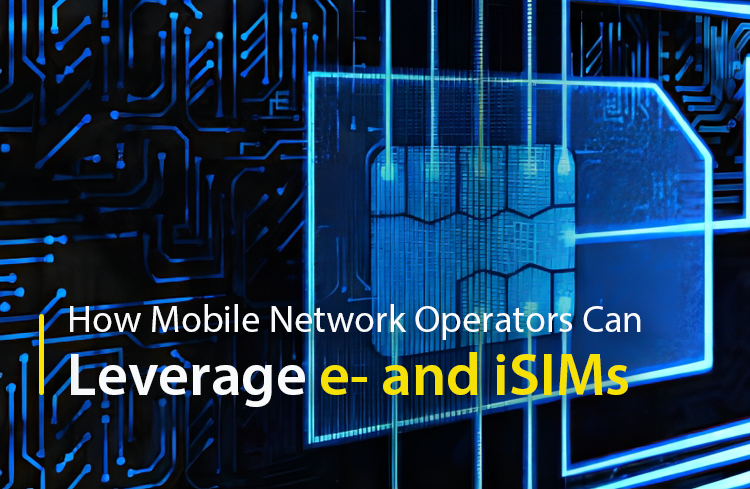
They're here and taking over! e- and iSIMs are becoming the de facto SIMs used in mobile and IoT devices. They will transform the way mobile network operators (MNOs) and mobile virtual network operators (MVNOs) interact with consumers and pave the way for new solutions, pricing models and business strategies. In this article, we explain what e- and iSIMs are, what they mean for the industry and how MNOs and MVNOs can leverage them to their advantage.
What is an eSIM?
eSIM stands for embedded SIM, or embedded subscriber identity model in full. Unlike traditional SIM cards, eSIMs are built into ('embedded' in) phones' hardware as chips. They are provider-agnostic and reprogrammable, which means that consumers can select and switch providers as and when they like.
eSIMS are already on the market in some high-end devices including Apple iPhones and Google Pixel lines. These devices all use eSIMs as a dual-SIM option, but some new phones are eSIM only, meaning they do not have a traditional SIM port at all.
What is an iSIM?
iSIM stands for Integrated Subscriber Identity Model. Unlike eSIMs, which are embedded into phones and IoT devices as a standalone chip, iSIMs are integrated into the main chip that powers phones and IoT devices.
iSIMs are not yet on the mass market. The semiconductor company Qualcomm recently announced that its flagship system-on-a-chip (SoC), the Snapdragon 8 Gen 2, has an iSIM, one of the first of its kind. It may not be long after eSIMs take over from SIMs before iSIMs become the new standard.
What is the difference between e- and iSIMs?
iSIMs are the next phase of SIM development. The functionality is similar to eSIMs in the sense that they offer the same "anytime, anywhere" connectivity, but iSIMs represent an advancement in terms of hardware because they negate the need for a standalone chip. From a manufacturing standpoint, e- and iSIMs are a logical next step for SIMs because:
· They will provide mobile devices more space internally to allow for larger batteries and other components.
· IoT devices can be made smaller, while devices that were previously too small to hold eSIMs can now join the network.
· Manufacturing costs will be lower, as there is no longer a need to manufacture standalone SIM or eSIM chips.
However, while the advantages for device manufacturing are obvious, it is actually consumers and MNOs/MVNOs that have the most to benefit from e- and iSIMs. Here's why.
What are the benefits of e- and iSIMs for consumers?
Waiting for a SIM card to arrive in the post or going out to buy one at a local kiosk will soon be a thing of the past. In the future, the process of switching network providers will be nearly instant. To connect to a new network, consumers will either download a provider's app or scan a QR code, choose a new contract and the network provider will deal with the rest.
However, arguably the best part about eSIMs is that you can have multiple eSIMs on a single device. There are multiple advantages to this:
· Consumers can essentially customize their own network package by picking and choosing providers for different things, like calls or mobile data, based on price and performance.
· Providers could specialize in specific solutions, bringing even greater value to consumers (e.g. 5GSA and IoT packages).
· Consumers who require a work and personal phone number can connect both lines to a single mobile device and toggle between them as needed.
· International travellers can add international plans to their device, removing the need to buy a new SIM when arriving at their destination.
What do e- and iSIMs mean for MNOs?
eSIMs enable consumers to change network providers much faster than before. This has huge repercussions for customer retention. If a network is too slow or unstable, the coverage is poor, the terms unfavorable or the contract too expensive, there is now less bureaucracy and friction holding consumers back from switching.
MNOs and MVNOs can benefit from new customer acquisition strategies, like free network trials. Because smart devices support multiple e- and iSIMs, consumers could trial a new contract without needing to cancel their old one. If the consumer is satisfied with the service, operators could automatically switch the consumer over to the new contract.
e- and iSIMs also open up new revenue streams for operators in the area of IoT. As e- and iSIMs enable IoT devices to connect to standalone cellular networks (rather than needing to be connected to WiFi like they used to,) MNOs and MVNOs can now access customers through a much broader range of devices. They can create packages for consumer IoT devices like wearables and smart home solutions, either including an IoT device like a smartwatch as part of a mobile package or as a separate contract. The number of use cases will only increase once iSIMs hit the mass market and more devices join the Internet of things or smart cities initiatives.
How can MNOs make e- and iSIMs a success
The transition to e- and iSIMs brings a lot of new territory for operators and consumers alike, making a robust testing strategy essential.
A key testing consideration is the contract switching experience. To leverage the full benefits that e- and iSIMs have to offer, operators must ensure consumers can connect to new networks quickly and easily. They should ensure that consumers can:
· Correctly update Access Point Name (APN) settings
· Seamlessly migrate to a new provider or contract
· Operate existing devices with the new network provider
· Use existing phone numbers on new eSIMs
· Download and use apps that act as digital eSIMs on older devices
· Automatically switch to a new contract after a free trial ends
e- and iSIMs are changing the game for MNOs and MVNOs when it comes to customer acquisition, retention and upsell. In an industry where it is now easier than ever for consumers to switch providers, operators must take digital quality seriously.
How crowdtesting can help
With a 1 million-strong community of global testers, Applause helps leading MNOs and MVNOs test their digital products in real consumer environments with thousands of unique devices. Whether you are launching a new product, migrating customers to a new solution or introducing different subscription models, Applause offers services spanning functional, UX, payments and IoT testing to ensure the best possible digital experience.
Source: https://www.applause.com/blog/how-mnos-can-leverage-e-and-isims

